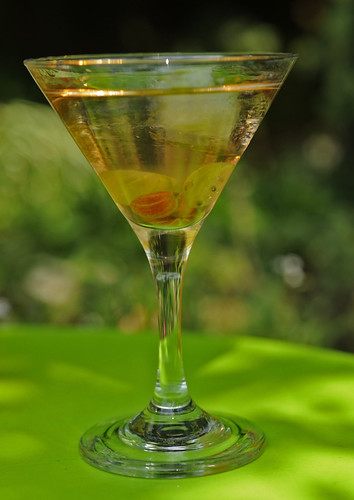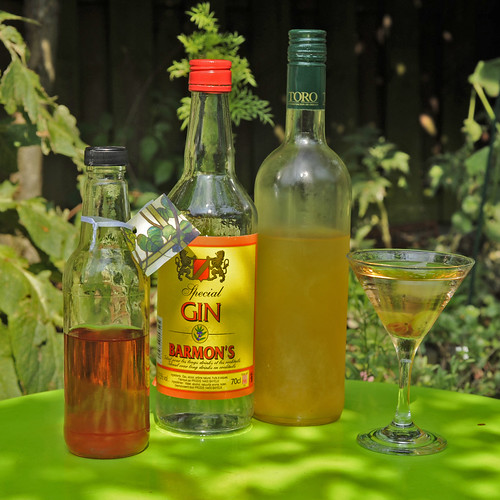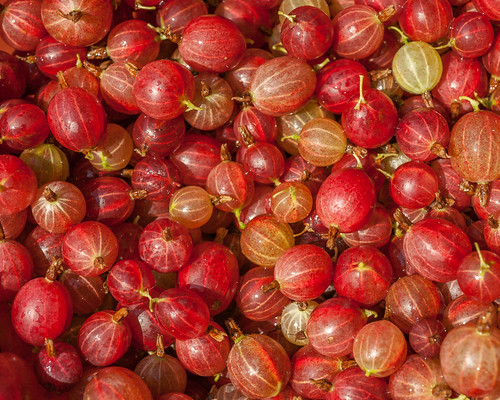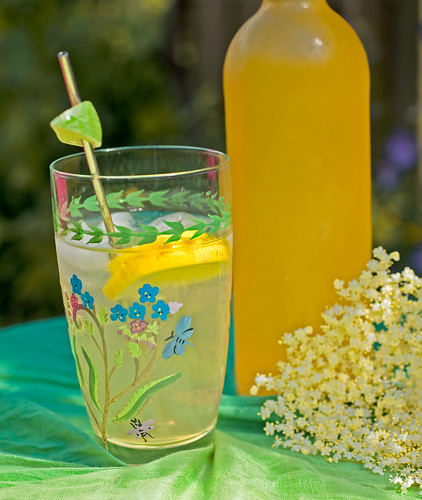Showing posts with label Cocktail. Show all posts
Showing posts with label Cocktail. Show all posts
Saturday, 18 July 2015
Friday, 17 July 2015
Thursday, 16 July 2015
Wednesday, 15 July 2015
Cocktail recipes: Reviving Those Crushed Spirits
Summer Fruit Cocktails
Instructions
Get a big & generous glass and fill the base with a couple of crushed summer fruits. Strawberries work well. You could try Raspberries, White, Red or Black Currants, Gooseberries or Cherries. Don't mix your fruits.
Cover the crushed fruit pulp with a good portion of white spirit. Gin works well. You might try Vodka or White Rum or Genever.
Add a lot of ice cubes.
Top up with Tonic or Soda Water.
Add some sliced or whole fruit. Like I said don't mix the fruits.
Here is a Strawberry Gin & Tonic I made earlier: Enjoy.
Sunday, 22 June 2014
Gin Infusions, Summer Cordials and Home-made Cocktails
Gooseberry Gin Martini

You will need:
2 Measures of Gin
1 Measure of Gooseberry infused Gin
1 Splash of Elderflower Cordial
A couple of fresh gooseberries for decoration and and ice-cube or two
Of course the trick is to have the home-made ingredients to hand.


Gooseberry Gin Recipe
If you are fortunate to have a glut of gooseberries one summer or can find some going cheap then this makes an interesting and tasty gin infusion.
You will need:
1 Litre of the cheapest gin
500 g of top & tailed and washed gooseberries, use pink ones for a lovely colour to the infusion
250 g sugar
Sterilise a preserving jar and fill with the gooseberries which you have halved or crushed. Add the sugar. You can use more or less sugar according to taste. Aim for less now and sweeten later if the infusion is too sour. Top the up the jar with as much gin as will fit in.
Leave to infuse for 6 to 8 weeks. Strain through a muslin cloth and transfer to sterilised bottles. Sweeten to taste if necessary.

Elderflower Cordial Recipe
In the early summer you can make a delicious cordial from Elderflowers.
You will need:
25 to 30 Elderflower heads freshly picked with the insects shaken off and quickly rinsed
1.5 Litre of water
Zest of 2 Lemons and 1 Orange
Juice of 2 Lemons and 1 Orange
1 kilo of sugar
50 g citric acid (optional)
Put the flowerheads in a large bowl with the zest, cover with 1.5 litres of boiled water and leave to infuse for 24 hours.
Strain the infusion through a muslin cloth and return to a pan with the sugar, the juice and the citric acid. Warm gently until the sugar is dissolved. Leave to cool and then transfer to sterilised bottles.

You will need:
2 Measures of Gin
1 Measure of Gooseberry infused Gin
1 Splash of Elderflower Cordial
A couple of fresh gooseberries for decoration and and ice-cube or two
Of course the trick is to have the home-made ingredients to hand.


Gooseberry Gin Recipe
If you are fortunate to have a glut of gooseberries one summer or can find some going cheap then this makes an interesting and tasty gin infusion.
You will need:
1 Litre of the cheapest gin
500 g of top & tailed and washed gooseberries, use pink ones for a lovely colour to the infusion
250 g sugar
Sterilise a preserving jar and fill with the gooseberries which you have halved or crushed. Add the sugar. You can use more or less sugar according to taste. Aim for less now and sweeten later if the infusion is too sour. Top the up the jar with as much gin as will fit in.
Leave to infuse for 6 to 8 weeks. Strain through a muslin cloth and transfer to sterilised bottles. Sweeten to taste if necessary.

Elderflower Cordial Recipe
In the early summer you can make a delicious cordial from Elderflowers.
You will need:
25 to 30 Elderflower heads freshly picked with the insects shaken off and quickly rinsed
1.5 Litre of water
Zest of 2 Lemons and 1 Orange
Juice of 2 Lemons and 1 Orange
1 kilo of sugar
50 g citric acid (optional)
Put the flowerheads in a large bowl with the zest, cover with 1.5 litres of boiled water and leave to infuse for 24 hours.
Strain the infusion through a muslin cloth and return to a pan with the sugar, the juice and the citric acid. Warm gently until the sugar is dissolved. Leave to cool and then transfer to sterilised bottles.
Wednesday, 27 March 2013
Baking in Paris
Gingerly: A Solid Cocktail
I spent another long w/e in Paris nominally in charge of a couple of kids whilst the parents were off gallivanting.
I might add that it was not 'baking' in Paris it was perishingly cold. Spring, I am reliably informed, is still weeks away and we can look forward to a White Easter and April snow showers. Great!
To ease the pain I ransacked the larder at the said establishment and thought I'd lessen the future possibilities for food poisoning by using as much of the beyond the 'sell by date' stuff as I could find.
Unfortunately this left me with the need to use Custard Powder and Jellies.
First up then was a Solid Cocktail. That is a cocktail made with Jelly but something more than an American College style Jello Shot. I only had two flavours to choose from, Orange or Raspberry. A deflated bottle of Ginger Beer was languishing in the fridge and of course the house was not without a bottle of Gin.
Method: the jelly was melted with as little boiling water as possible and left tio dissolve and cool. A good shot of Gin was added and topped off with the remains of the Ginger Beer. Two tall glasses were found and the cocktail was poured into these and placed in the fridge to set overnight.
The glasses were tall Mort Subite glasses: this is a Belgium Lambic or Geuze fruit beer which comes in Cherry, Raspberry and Peach flavours. The beer is sold in a traditional cafe of the same name in Brussels where the beer is sold on draught by suitably moody waiters.
When examined the following day the cocktails had set and a taste of one revealed that they still had a fizziness captured within. The second cocktail was then left outside the fridge until it melted to the extent that the bubbles were starting to be released and it was then placed back in the fridge so that the bubbles, now enlarged and visible, were captured in the set.
Kit-Kat Kustard Kake
My current favourite baker is Dan Lepard. His 'Short and Sweet' book is genius.
This recipe is based on Dan's Apple, Walnut and Custard Cake, which is from the book mentioned.
The recipe is really three recipes in one.
First make a custard using the custard powder and make it using half the quantity of milk specified and pour it into a shallow container and leave it to cool in the fridge until it is set solid. You should be able to cut it up into wobbly blocks.
Second make your sponge mixture. Whatever you favourite proportions are, cream the butter and sugar, add the eggs, and then stir in the raising agent and flour.
Third make your topping. Dan caramelises apples with sugar and walnuts. You could use anything. We used Kit-Kat Balls which are like Maltesers. Which to use? Unfortunately K-Ks are Nestle.
Final preparation is to cut up the wobbly set custard and stir the blocks into the cake mixture gently and then pour into a cake tin and then poke in as many chocolate balls as you can. In retrospect we think a more gooey chocolate ball might work better, Rolo's perhaps.
Bake in the oven at 200c for 50 minutes or whatever.
Doughnuts
By special demand I was asked to make doughnuts. Not a bad idea as we could make a huge batch of dough and use some for doughnuts and some for pizza. I also reserved some for Croissants but the less said about that the better. Croissants! in Paris? What was I thinking?
Meanwhile we rustled up a dough and put most of it aside for pizza later.
After the usual palaver the first rising was knocked down and divided into 9 balls: 3 doughnuts each. A hole was punched into each to make the classic ring shape and these were left to prove a second time.
Next up a frying pan was filled with a 2cm depth of sunflower oil and these was heated to a dangerous temperature and tested by dropping a small piece of dough in. If it fizzed and browned immediately it was hot enough. The risen doughnuts were dropped in, two at a time, and browned on each side, before being lifted out and drained on a napkin. The hope was that they were sufficiently cooked on the inside without being scorched on the outside. A tricky business.
The next problem was getting the sugar coating to stick. Who knew this could be a problem? We had to brush them with sugar water before rolling them in granular sugar. (An attempt to colour this sugar was a failure). The doughnuts were then iced with a paste of coloured icing sugar. Again it was difficult to colour and the icing ran straight off the doughnut.
So the presentation of the doughnuts wasn't really up to standard. However they were piping hot, were sufficiently sticky on the outside and gooey in the middle and gave an immediate sugar rush which migrated to a sugar migraine which remained for the rest of the day. Nice!
In future I'll take the kids to a funfair (preferably in Belgium) where you can observe a machine automatically make the mini-doughnuts which are dropped into a canal of oil where they float along as they cook, are flipped over half-way along and then tipped out into sugar quarry before before served in paper cones.
A Jelly Trio
This dessert took three days to assemble and also made use of the out-of-date materials.
The bottom layer was a Raspberry Jelly dissolved in the usual way with boiling water, but then diluted with only half as much cold water specified. A stronger jelly resulted. This was placed in a series of glasses in the fridge.
The middle layer was made by mixing up a custard using the custard powder and sugar and adding an equal amount of drinking chocolate powder. These were creamed together using some hot milk and then diluted with the rest of the hot milk. Only half as much milk was used as per the instructions on the box. Some real chocolate was thrown into the mix to give give an extra chocolate lift and deepen the colour. When this was sufficiently cool and gloopy it was poured on top of the set jelly in the glasses.
The top layer was the most problematical. What we wanted was a Pink Blancmange. Once again however we were foiled by the uselessness of our colouring agents and the milk resolutely refused to go pink even after we added some strawberry cordial. To make the milk set we dissolved some sheets of gelatin in cold water and then wrung them out before mixing them into the warmed milk. In future we would probably use agar as our setting agent. It took an age for the blancmange to start to set but eventually we risked pouring it on top of the jelly and chocolate layers already assembled and left it to set overnight.
It turned out very well, though of course the Blancmange was NOT pink.
Subscribe to:
Posts (Atom)





